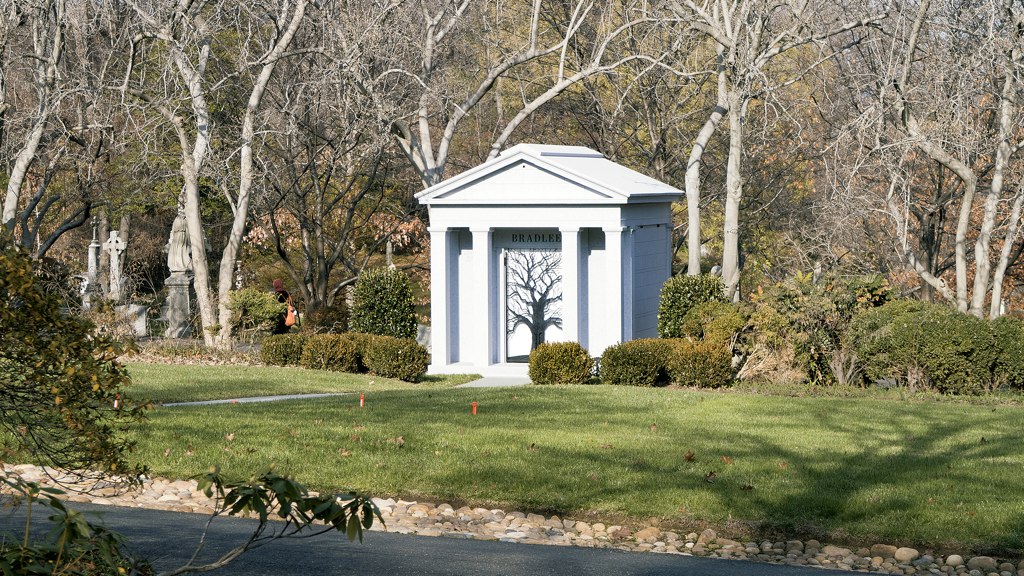Eighteen months after his funeral, Ben Bradlee may finally be able to rest in peace.
Following a kerfuffle last fall over the legendary Washington Post executive editor’s gravesite, the District has changed its building codes and reversed its original permitting decision, all but ensuring that Bradlee’s remains will stay undisturbed in the mausoleum that sparked a controversy.
This past October, roughly a year after his death, Bradlee’s remains were entombed in a neoclassical mausoleum just inside the entrance to Georgetown’s historic Oak Hill Cemetery. Bradlee’s widow, the writer Sally Quinn, had commissioned the construction of the structure, which has four columns and the name “Bradlee” emblazoned prominently above its door.
It didn’t take long for Georgetown residents to complain about the mausoleum’s size and location, and the grumbling soon reached the desk of Charles A. Birnbaum, the president and CEO of the Cultural Landscape Foundation, which advocates for historic outdoor spaces. “You go through the gates now and ‘Bradlee’ reads like a billboard,” Birnbaum told me in December. “That’s a major impact on the arrival experience at Washington’s most historic rural cemetery.”
Birnbaum began investigating the mausoleum and discovered that it had been constructed without a building permit, the filing of which triggers Georgetown’s notoriously onerous–and public–review process, which can drag on for years. When the district’s Department of Consumer and Regulatory Affairs reviewed the structure in October, the agency determined that–although it was an unusual case–a permit was indeed required.
But neither Quinn nor the cemetery ever filed to obtain a building permit. Instead, representatives of the cemetery contacted DCRA officials for a sit-down and the two sides met, says Matt Orlins, the agency’s legislative-and-public-affairs director. In written responses to questions, Orlins wouldn’t say what was discussed at that meeting, citing agency policy of not commenting on conversations between attorneys. But shortly after the meeting, the agency took a second look at the issue.
Agency officials examined how this issue is handled in other jurisdictions and, according to Orlins, they determined that “a permitting requirement for small mausoleums was inconsistent with best practices nationally and unnecessary from a safety perspective.”
This review focused on how local governments, as opposed to individual cemeteries, dealt with mausoleum-related issues, Orlins says.
Agency officials also asked the District’s Construction Codes Coordinating Board, a 13-member board with the authority to make changes to construction codes, to consider an amendment exempting family mausoleums from permitting requirements, according to board chair Jill Stern. On March 17, after roughly two months of deliberations, the board approved the amendment, which, according to Orlins, clarified that “mausoleums of less than 250 square feet that are not inhabitable and have no utility connections do not require a DCRA permit.”
On account of this change to the building code, the city will not pursue work-without-a-permit infractions against Quinn, Orlins says.
In an interview Wednesday, Birnbaum called the city’s actions a “back-room deal” crafted specifically for the Bradlee mausoleum. “The square-footage requirement that they’ve come up with,” he says, “conveniently accommodates this new mausoleum.”
Quinn declined to comment for this story. But Orlins insists that the city’s decision-making process wasn’t influenced by any individual. “The discussion focused on whether the erection of a small mausoleum should require a permit,” he says, “a specific owner did not factor into our analysis.”
Nevertheless, Birnbaum says the new regulations miss the point. It’s the Bradlee mausoleum’s location at the entrance the cemetery–and visible from the street–that is his overriding concern.
“If they would have actually built it on the downhill side slope, as other ones have been built, we wouldn’t be having this conversation,” he says. “This is literally just right there front and center, and it ignores 150 years of visual and spacial continuity of not just the cemetery’s design but it’s relationship to one of the most important historic districts in the nation’s capital.”


![Luke 008[2]-1 - Washingtonian](https://www.washingtonian.com/wp-content/uploads/2017/10/Luke-0082-1-e1509126354184.jpg)

















